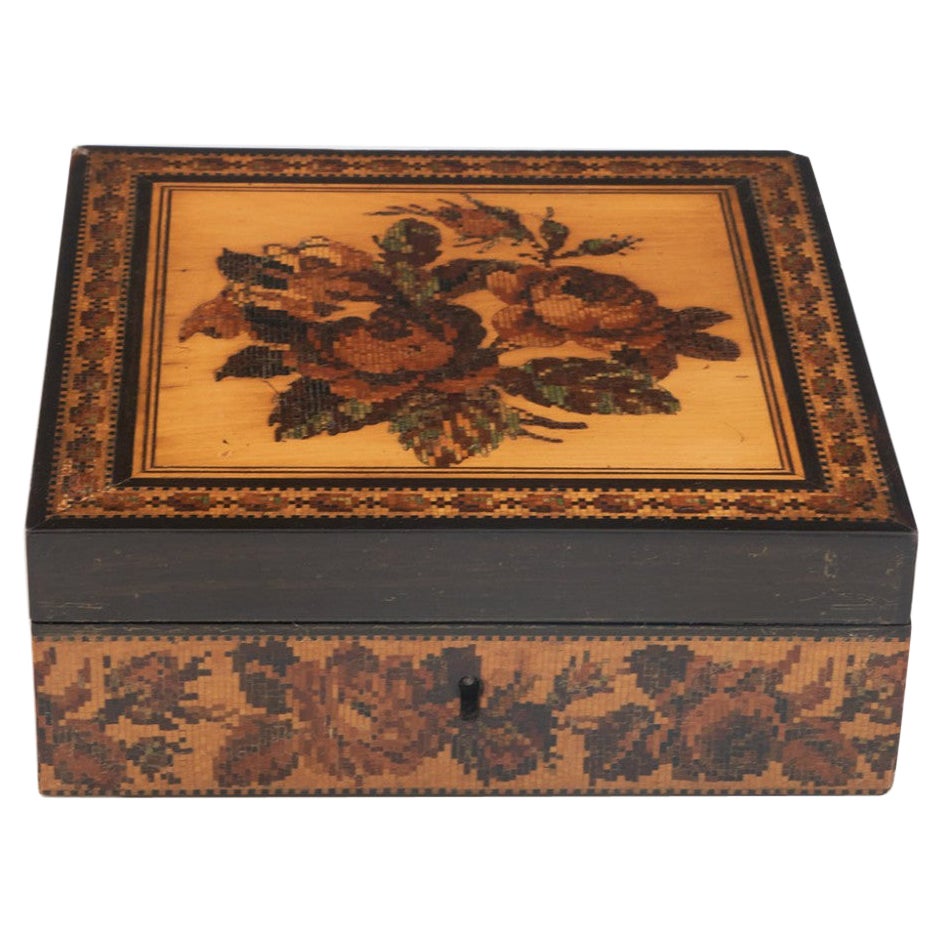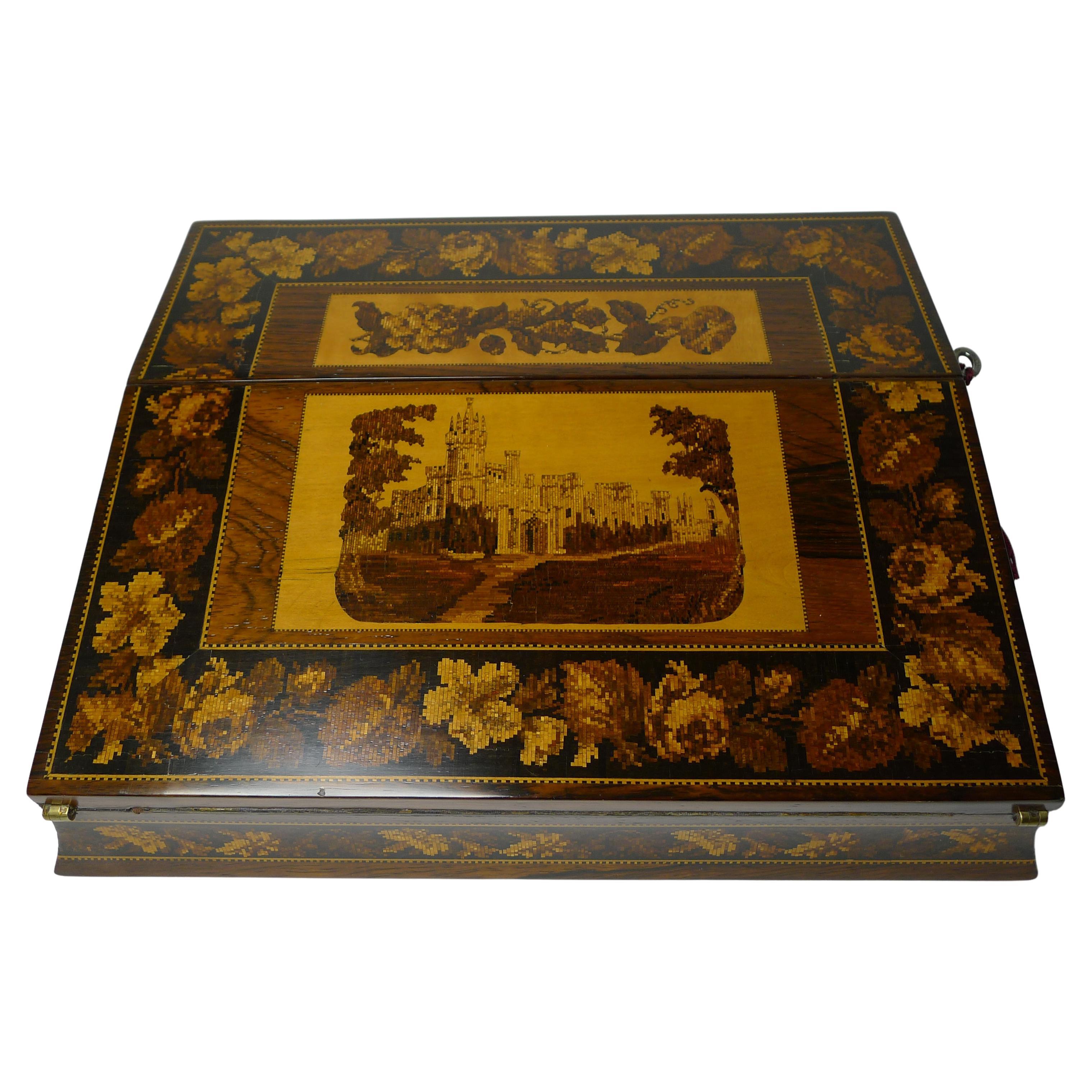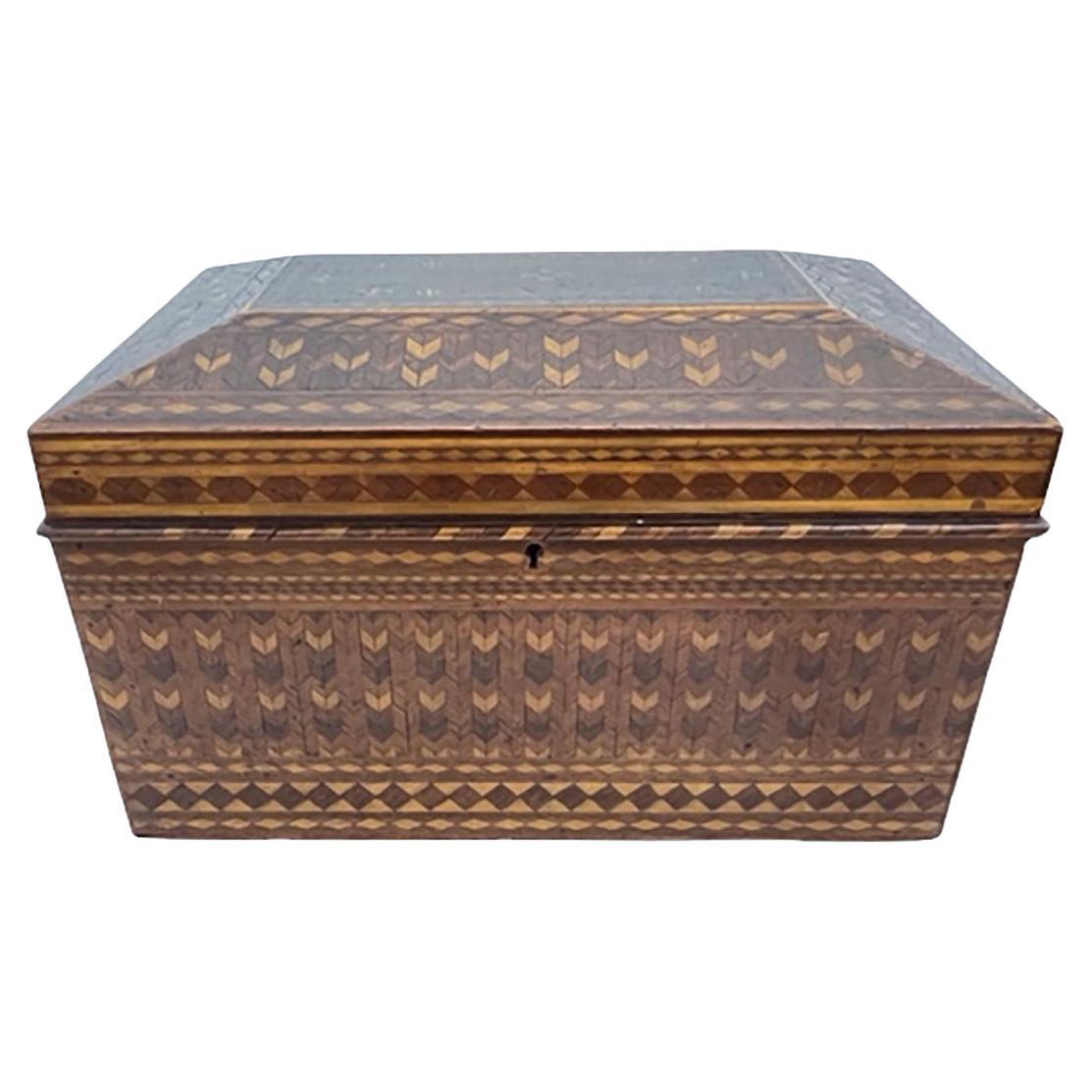Items Similar to Tunbridge Ware Correspondence Box by Edmund Nye 19th Century
Want more images or videos?
Request additional images or videos from the seller
1 of 11
Tunbridge Ware Correspondence Box by Edmund Nye 19th Century
About the Item
Mid 19th century Tunbridge ware stationery box by Edmund Nye, manufacturer.
The dome-shaped top is inlaid with a specimen parquetry panel, crossbanded with boxwood and stringing and Tunbridge ware borders. The lid is hinged and lifts up to reveal four stationery dividers and retains the original embossed paper. The hinges are marked with the maker's impress: P. M & C patent. The hinges are made in such a way that they allow the lid to lay down completely. The entire box is veneered in a lively quilted walnut burr, satinwood, ash and crossbanded in a broad floral Tunbridge ware border. The underside retains the maker's label: 'Edmund Nye, Manufacturer, Mount Ephrain and Parade Tunbridge Wells.
Tunbridge ware items originate from the beautiful spa town of Royal Tunbridge Wells in Kent. Tunbridge became known in the 17th Century for its therapeutic waters and by the 18th century it had become a hugely popular spa resort. Shops and stalls were set up to sell local work of distinction to visitors as souvenirs.
The original Tunbridge ware boxes were decorated with all sorts of different kinds of designs. Many had a central image with views of castles, churches, pavilions, animals, country scenes and sometimes people, such as the Young Prince of Wales. These were surrounded by a variety of bandings and panels of floral and geometric designs. The famous makers of Tunbridge ware produced their most notable work from about 1830 to 1900.
Literature
Edmund Nye (b. 1797 d. 1863) of Parade and Mount Ephraim, Tunbridge Wells was a Tunbridge ware maker and print publisher.
Edmund was the son of James Nye. He became a junior partner to William Fenner Senior and they traded as Fenner & Nye until 1817 when the partnership was dissolved. Nye then opened his own workshop in the nearby market place. Nye was one of the makers considered for the production of a writing table for Princess Victoria in 1826, but William Fenner was ultimately chosen. Nye did however received patronage from the Duchess of Kent.
In 1840 the business of Fenner & Co was put into receivership; Nye and his father took over the repository, and then in 1844 the workshops on Mount Ephraim. Nye appears to have carried out extensive building works as trade card engravings depict a single larger and deeper building than the separate repository and workshops shown on the earlier Fenner & Co cards (a trade card for Edmund Nye, c.1830 is in the John Johnson Collection, Bodleian Library).
Several prints published by Nye prior to this period are known. One decorated with an illustration of the Baths is dated 1827 and another of the Parade includes Nye’s shop, displaying its facia board reading: ‘MANUFACTURER E. NYE TUNBRIDGE WELLS’. During this period he also opened a shop in Hastings at 10 Castle Street Priory (1826-35). An 1827 print exists with this address on the imprint as well as the Tunbridge Wells one, although the view is of Mount Edgcumbe, Tunbridge Wells.
Nye was a regular user of paper labels on many of his products. One early label reads: ‘NYE/Late Fenner & Nye’/Manufacturer/Tunbridge Wells’, c. 1840. A rectangular one with a decorative border ‘FROM NYE’S/(LATE FENNER & NYE)’ c. 1845, and a third label, with a different decorative border, states ‘EDMUND NYE, MANUFACTURER/Mount Ephraim and Parade,/TUNBRIDGE WELLS’ c. 1848-1853.
By the mid-1850s larger rectangular and also circular labels were used.
During the same period metal dies were used to stamp the interiors of small boxes. These same 1850s labels and marks were used after 1864 with the name changed to Thomas Barton. Thomas Barton (1819–1903), previously apprenticed at the Wise factory, joined the Nyes in 1836, and worked as Nye's designer. His skills were dutifully recognised by Nye and he employed him to work on the exhibits Nye showed at the 1851 Great Exhibition in Hyde Park. Nye displayed four items: a table with the top exhibiting a mosaic ship in full sail (claimed to incorporate 110,800 pieces of wood); a ‘chromatrope table’ decorated with two North American birds (129,000 pieces of wood); a book stand with panels of tropical butterflies; and a workbox with a view of the ruins of Bayham Abbey. Nye received a commendation from the judges for his work.
Items decorated in a similar manner were included in Nye’s stock including a bookstand decorated with tropical birds and the use of such birds on boxes. Other views employed by Nye included Eridge Castle as shown on a rosewood reading stand c. 1845 bearing a later Fenner & Nye label. The veneer wood used for his marquetry objects – such as some of the 1851 exhibits – were often light in colour to highlight the marquetry. A number of new bandings were produced in this period often of geometrical form rather than those based on flowers and leaves. Veneers were produced copying tile patterns and were used for the tops of larger boxes. Nye claimed the colours of the wood that he used were natural and produced boxes of specimen woods (often 45 different specimens) which included the green wood resulting from fungus infected oak.
Nye died in 1863. His will provided for the business to be taken over by his ‘Foreman’ Barton, an option he readily accepted until his own death.
‘The Chalet’ was the home and workshop of Edmund Nye and Thomas Barton, in Tunbridge Wells and the building still has a plaque commemorating them.
Sources: DEFM; Austen, ‘Tables by Tunbridge Ware Makers’, Furniture History (1997);
Austen, ‘A Tunbridge Ware Work Table by Fenner & Co.’, FHS Newsletter (August 2002);
Stabler, ‘Furniture Makers’ Trade-Cards and Bill-Heads in the John Johnson Collection’, FHS Newsletter (May 2007).
- Creator:Edmund Nye Tunbridge Wells (Cabinetmaker)
- Dimensions:Height: 5.52 in (14 cm)Width: 9.06 in (23 cm)Depth: 4.34 in (11 cm)
- Style:Georgian (Of the Period)
- Materials and Techniques:
- Place of Origin:
- Period:
- Date of Manufacture:1840
- Condition:Wear consistent with age and use.
- Seller Location:Cheltenham, GB
- Reference Number:1stDibs: LU6909237154762
About the Seller
5.0
Vetted Seller
These experienced sellers undergo a comprehensive evaluation by our team of in-house experts.
1stDibs seller since 2022
10 sales on 1stDibs
- ShippingRetrieving quote...Ships From: Cheltenham, United Kingdom
- Return PolicyA return for this item may be initiated within 3 days of delivery.
More From This SellerView All
- French Walnut Burr Campaign Writing Slope Brass Inlay 19th CBy Napoléon IIILocated in Cheltenham, GBAn exceptionally fine quality example of an early 19th century burr wood campaign writing slope, in beautifully grained burl, with polished brass inlaid, of French origin. Opening to...Category
Antique Early 19th Century French Napoleon III Desk Sets
MaterialsBrass
- Inkwell Charles X French Gothic in Patinated Bronze, 19th CenturyLocated in Cheltenham, GBInkwell Charles X French Gothic in Patinated Bronze, Early 19th Century Gothic inkwell in patinated bronze and fine chiseled bronze decorated with arcatures, rosettes, polylobed mo...Category
Antique Early 19th Century French Charles X Inkwells
MaterialsBronze
- French Bronze and Gilded Bronze Inkwell and Candlestand 19th CenturyLocated in Cheltenham, GBA large and impressive early 19c French bronze and gilt bronze inkwell, the central chased handle with a pair of candle arms terminating in lion masks, 2 tray wells either side of a ...Category
Antique 19th Century Desk Sets
MaterialsBronze
- Jewelry Box Apprentice Chest Brass Engraved Thistle MiniatureLocated in Cheltenham, GBChest of Drawers Jewelry Box Apprentice Chest Brass Engraved Solid brass apprentice chest of drawers, chest with 5 working drawers all with stylized...Category
Early 20th Century British Jewelry Boxes
MaterialsBrass
- Tea Caddy Yew Boxwood Inlaid English George IIILocated in Cheltenham, GBA fine 18th century satinwood and yew tea caddy, the oval burr panels figuring on all sides with boxwood banding and bone knob to the lid. Wonderful patination and remnants of silver...Category
Antique 18th Century English Georgian Tea Caddies
MaterialsBoxwood, Yew, Satinwood
- Regency Leather Studded Campaign Case Trunk by Chapple & Sons Initials "I.M"Located in Cheltenham, GBRegency leather studded traveling case by Chapple & Sons of Cheapside London with studded brass initials ( I * M ) This compact Regency trunk is constru...Category
Antique 19th Century British Regency Decorative Boxes
MaterialsBrass
You May Also Like
- English Mid 19th Century Micro Tunbridge Glove Box with Makers Label Edmund NyeBy Edmund Nye Tunbridge WellsLocated in Wells, MEEnglish tunbridge domed glove box with original maker's label Edmund Nye (1840-63). This micro inlaid domed glove box has various woods including rosewood, boxwood, mahogany and w...Category
Antique Mid-19th Century English Early Victorian Decorative Boxes
MaterialsSilk, Boxwood, Rosewood, Walnut
- 19th Century British Tunbridge Ware Lap DeskBy Tunbridge WareLocated in Dallas, TXPresenting an absolutely gorgeous and extremely unique and rare 19th Century British Tunbridge ware lap desk. This lap desk is unlike any of it’s kind we have seen before. From cir...Category
Antique Mid-19th Century English High Victorian Decorative Boxes
MaterialsWood, Ebony, Maple, Satinwood, Walnut
- Tunbridge Ware Handkerchief Box Edmund Nye, circa 1860By Edmund Nye Tunbridge WellsLocated in Tunbridge Wells, GBTunbridge Ware Edmund Nye Square Handkerchief Box, circa 1860 Although labelled, the form of this box - and especially the lining paper - are consistent with other pieces identified as coming from Edmund Nye's manufactory; the influence of Thomas Barton can be defined from the inclusion of his signature green oak tesserae in the design prior to Barton assuming control of the business in 1862 Additional Information: Date: c1860 Period: Victorian Origin: Tunbridge Wells; England Decoration: A low, square box with a pin-hinged lid; decorated with a neo-clasical frame around a floral mosaic. To the four side faces of the box, a Berlin woolwork...Category
Antique 19th Century English Victorian Picture Frames
MaterialsPorcelain
- Fine Tunbridge Ware Writing Box / Lap Desk, Eridge Castle, circa 1870Located in Bath, GBA truly fine example of a Victorian Tunbridge Ware writing box or lap desk dating to circa 1870. The central section featuring Eridge Castle, East Sussex. The box comes complete w...Category
Antique 1870s British Late Victorian Decorative Boxes
MaterialsWood
- 19th Century Wood Stationery BoxLocated in Hamilton, Ontario19th century wood stationery box.Category
Antique 19th Century British Decorative Boxes
- Tunbridge Ware BoxLocated in Dallas, TXLarge Tunbridge ware box with herringbone pattern inlaid parquetry. Circa 1840, England.Category
Antique 1840s English Decorative Boxes
MaterialsWood
Recently Viewed
View AllMore Ways To Browse
19th Century Victoria Furniture
Georgian Book Stand
19th Century Tunbridge Ware Writing Box
Wood A Reading Desk
Burr Walnut Partners Desk
Duchess Desk
45 Writing Desk
Junior Desk
Small Veneer Box
Tunbridge Ware Box
Priory Table
Georgian Reading Table
Desk Bookstand
Etruscan Basin
Antique Desk Ware
Metal Desk Organizer
Dragon Wooden Ashtray
Money Box Piggy Bank





